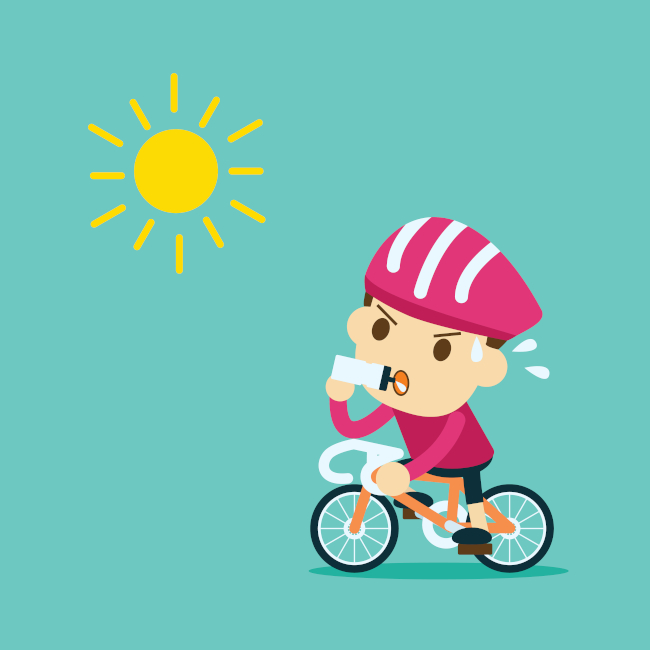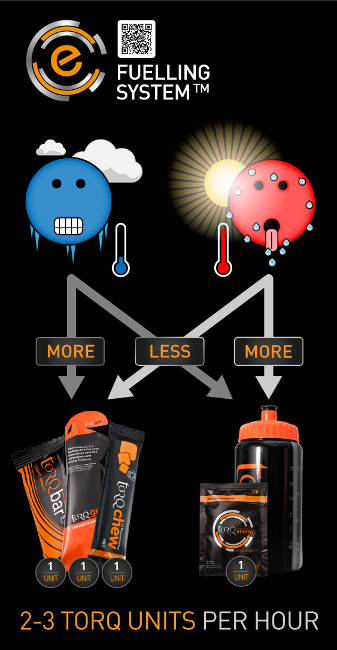Has your stomach rejected the food or drink you’ve consumed whilst exercising? Have you felt bloated or sick whilst taking energy products? We explain why this might be happening to you and discuss how TORQ’s fueling products have been formulated to mitigate the issue.
You might call it indigestion or stomach pain, whilst Sports Scientists often refer to it as gastrointestinal distress or GI distress, however I think we can all agree that it’s an undesirable and unpleasant experience to have whilst exercising. For the purposes of clarity and avoidance of ambiguity, we will refer to the phenomenon as ‘GID’ for the remainder of this article.
Many seasoned athletes have struggled with GID during exercise at some point in their careers as well as those of you with perhaps less experience, who have tried to follow a formal fueling strategy at some point. The good news is that there are a set of rules, which if adhered to should see any problems you have in this department minimized or even disappear altogether:
Exercise intensity: The higher the exercise intensity, the more physiological stress the body is put under and the more that blood is diverted away from digestion/absorption sites to the working muscles, which can clearly be a trigger for GID. Ironically, the higher the intensity of exercise, the more necessary fueling becomes, due to the greater energy requirements. However, although exercise intensity heightens one’s GID sensitivity, all this really means is that you’ve got to get everything else right, because we can’t be telling you to slow down can we? Read on to learn about how to create the best possible environment for your digestive system to minimize GID.

Overconsumption: It’s simple, if you consume too much ‘fuel’ don’t be surprised if you get GID, because your gastrointestinal tract won’t be able to process the nutrients fast enough. In the same way that eating a large meal will leave you feeling bloated and lethargic, the concept is no different whilst exercising, in fact it’s obviously heightened. What is not so simple to understand is which foods/nutrients are most easily absorbed, but we will make sure this is explained clearly over the next few paragraphs. Any normal food you’ve consumed prior to training or competition needs to have been fully digested by the time you exercise too. Fuel consumed during exercise needs a clear run to the intestine, the site of absorption or it will back-up causing GID.
Fat & Protein: Neither of these nutrients have any place in an energy product and will block the absorption of carbohydrate, which is the ONLY relevant nutrient for fueling. Essentially, if you block the absorption of this vital nutrient, not only will you restrict the performance benefits, but you will undoubtedly cause GID. We discuss this in great detail in our article The Anatomy of an Energy Bar which is well worth a read (on our UK site). In this piece, we talk about what constitutes the perfect energy bar and address what to look out for and what to avoid. There are a number of flawed products available, which confusingly are marketed as ‘Energy Bars’. Of course we would never advocate the removal of fat and protein from your diet, as they are essential to life, but there is a time and a place for their consumption and understanding this is critical. They have no place in your energy products.

Formulation: We’ve established that an energy product shouldn’t contain fat or protein, so what should it contain? From a calorie/energy perspective the only nutrient should be carbohydrate, however both water and electrolytes are also vital to the fueling/hydration process. We discuss hydration and dehydration further on, so let’s focus on carbohydrate here. The mechanics of carbohydrate absorption are fundamental to TORQ’s research and development, so we understand a thing or two about this. Please take the time to read our very recent The Best Just Got Better article (our UK site) where we provide a history of the science behind carbohydrate fueling. The article explains how research by Virbay and colleagues (2020) has demonstrated that elite mountain marathon runners were able to take onboard 120 grams of carbohydrate per hour during high intensity competition without experiencing GID. The research examined a 2:1 Glucose:Fructose blend, which is the same formulation used in TORQ’s Fueling System products. In short, research has proven that GID is reduced if a 2:1 Glucose:Fructose formulation is ingested.
Practice: The research by Virbay and colleagues (2020) also highlighted how ‘training the gut’ to cope with high levels of carbohydrate ingestion is very important, so you shouldn’t turn up to an event and follow a fueling protocol that you haven’t rehearsed in training. That said, the study was looking at extremely high levels of carbohydrate ingestion and although it’s best practice to rehearse any nutritional strategy, all being equal, you are much less likely to experience GID on 2:1 products than other formulations. Our advice has always been to consume 60-90 grams of carbohydrate per hour via TORQ products with the emphasis being on 60 grams for people new to fueling. 60 grams of carbohydrate per hour is half the amount of carbohydrate used in the 2020 study, so common sense dictates that GID would be near impossible at this intake. It’s important to note that the same couldn’t be said for 60 grams per hour of a glucose-only formulation, which would put much more pressure on the gastrointestinal tract. Again, our The Best Just Got Better article explains this in more detail, as do our TORQ Fueling System pages. If you are new to TORQ, bear in mind that our fueling products each contain 30g of carbohydrate - called a TORQ Unit - so it is very easy to regulate your intake.

Dehydration: Getting the balance right between fueling and hydration can be tricky, which is why we developed the TORQ Fueling System which regulates the balance between your fuel, fluid and electrolyte intake. If you become dehydrated, a concentrated carbohydrate fuel source hitting your GI tract can cause significant discomfort. This is because water has to be drawn from the blood into the intestine to effectively ‘water down’ the concentrated carbohydrate source so that it can be reabsorbed. It’s a process called osmosis which is affected by the tonicity (its concentration) of a solution/food and the state of hydration your body is in. In a dehydrated state, the intestine doesn’t take kindly to this process – when adequately hydrated it doesn’t represent a problem. To thoroughly understand this area, please read our article Isotonic, Hypotonic or Hypertonic Products. Essentially, when exercising, you need to address both your fueling and hydration needs. Fueling has been discussed above and this needs to be a 2:1 carbohydrate blend to minimize GID. Your hydration needs are determined by the amount of fluid you lose through perspiration – the more you sweat, the more fluid and electrolytes you need to put back in. The TORQ Fueling System addresses this by ensuring that you drink your carbohydrate if perspiration rates are higher and eat it when they are lower.

Unnecessary & Unnatural Ingredients: A key philosophy of ours at TORQ is to use organic ingredients where possible (many of our products are certified organic), because these will be the purest and kindest to the stomach (as well as benefiting your overall health). Similarly, we refuse to use ingredients that are simply not necessary like artificial sweeteners, colors and additives. If it doesn’t assist in the performance of the product, why include it? What benefit does food coloring have for instance? Choose a product that is pure, natural and stripped-back as far as possible to its purely functional nutrients.

In Summary: Leave adequate time between eating regular food and your exercise session/event. Ensure that your energy fuel contains only carbohydrate, unless of course it has a hydration function and should therefore contain water an electrolytes too. Fat is the enemy, so avoid it all costs, and protein has no place in an energy product except under very specific circumstances. Ensure the formulation is 2:1 Glucose:Fructose (as per TORQ’s Fueling System products) and that the product utilizes pure natural ingredients with no unnecessary additives. And finally, stay on top of your hydration and replace the fluids you lose.
We hope you found this article interesting and informative. If you have any questions about this article or anything else on our website, please don’t hesitate in contacting us at info@torqusa.com .
Research References
Viribay, A., Arribalzaga, S., Mielgo-Ayuso, J., Castañeda-Babarro, A., Seco-Calvo, J. and Urdampilleta, A. (2020)
Effects of 120 g/h of Carbohydrates Intake during a Mountain Marathon on Exercise-Induced Muscle Damage in Elite Runners. Nutrients, 12(5), p.1367.
Stellingwerff, T & Cox, GR. (2014)
Systematic review: Carbohydrate supplementation on exercise performance or capacity of varying durations. Appl Physiol Nutr Metab. 2014 Sep;39(9):998-1011.
Wilson. PB., Ingraham, SJ. (2015)
Glucose-fructose likely improves gastrointestinal comfort and endurance running performance relative to glucose-only. Scand J Med Sci Sports. [Epub ahead of print].
Currell, K & Jeukendrup, A.E. (2008)
Superior endurance performance with ingestion of multiple transportable carbohydrates. Med Sci Sports Exerc. 40(2):275–81.
Triplett, D., Doyle, D., Rupp, J., Benardot, D. (2010)
An isocaloric glucose-fructose beverage’s effect on simulated 100-km cycling performance compared with a glucose-only beverage. Int J Sport Nutr Exerc Metab. 20(2):122–31
Tarpey, M.D., Roberts, J.D., Kass, L.S., Tarpey, R.J., Roberts, M.G. (2013)
The ingestion of protein with a maltodextrin and fructose beverage on substrate utilisation and exercise performance. Appl Physiol Nutr Metab. 38(12):1245–53.
Rowlands, D.S., Swift, M., Ros, M., Green, J.G. (2012)
Composite versus single transportable carbohydrate solution enhances race and laboratory cycling performance. Appl Physiol Nutr Metab. 37(3):425–36.
Baur, D.A., Schroer, A.B., Luden, N.D., Womack, C.J., Smyth, S.A., Saunders, M.J. (2014)
Glucose-fructose enhances performance versus isocaloric, but not moderate, glucose. Med Sci Sports Exerc. 46(9):1778–86.
Rowlands, D.S., Thorburn, M.S., Thorp, R.M., Broadbent, S.M., Shi, X. (2008)
Effect of graded fructose co-ingestion with maltodextrin on exogenous 14C-fructose and 13C-glucose oxidation efficiency and high-intensity cycling performance. J Appl Physiol. 104:1709–19.
O’Brien, W.J & Rowlands, D.S. (2011)
Fructose-maltodextrin ratio in a carbohydrate-electrolyte solution differentially affects exogenous carbohydrate oxidation rate, gut comfort, and performance. Am J Physiol Gastrointest Liver Physiol. 300(1):G181–9.
O’Brien, W.J., Stannard, S.R., Clarke, J.A., Rowlands, D.S. (2013)
Fructose–maltodextrin ratio governs exogenous and other CHO oxidation and performance. Med Sci Sports Exerc. 45(9):1814–24.
Rowlands, D.S., Swift, M., Ros, M., Green, J.G. (2012)
Composite versus single transportable carbohydrate solution enhances race and laboratory cycling performance. Applied Physiology, Nutrition, and Metabolism. 37(3): 425-436.
Smith, J.W., Pascoe, D.D., Passe, D., Ruby, B.C., Stewart, L.K., Baker, L.B., et al. (2013)
Curvilinear dose-response relationship of carbohydrate (0–120 gh−1) and performance. Med Sci Sports Exerc. 45(2):336–41.
Roberts, J.D., Tarpey, M.D., Kass, L.S., Tarpey, R.J., Roberts, M.G. (2014)
Assessing a commercially available sports drink on exogenous carbohydrate oxidation, fluid delivery and sustained exercise performance. J Int Soc Sports Nutr. 11(1):1–14.
Jentjens, R.L., Underwood, K., Achten, J., Currell, K., Mann, C.H., Jeukendrup, A.E. (2006)
Exogenous carbohydrate oxidation rates are elevated after combined ingestion of glucose and fructose during exercise in the heat. J Appl Physiol. 100(3):807–16.
Jeukendrup, A.E & Moseley, L. (2010)
Multiple transportable carbohydrates enhance gastric emptying and fluid delivery. Scand J Med Sci Sports. 20(1):112–21.
Davis, J.M., Burgess, W.A., Slentz, C.A., Bartoli, W.P. (1990)
Fluid availability of sports drinks differing in carbohydrate type and concentration. Am J Clin Nutr. 51(6):1054–7.
Jentjens, R.L., Venables, M.C., Jeukendrup, A.E. (2004)
Oxidation of exogenous glucose, sucrose, and maltose during prolonged cycling exercise. J Appl Physiol. 96(4):1285–91.
Jentjens, R.L., Achten, J., Jeukendrup, A.E. (2004)
High oxidation rates from combined carbohydrates ingested during exercise. Med Sci Sports Exerc. 36(9):1551–8.
Wallis, G.A., Rowlands, D.S., Shaw, C., Jentjens, R.L., Jeukendrup, A.E. (2005)
Oxidation of combined ingestion of maltodextrins and fructose during exercise. Med Sci Sports Exerc. 37(3):426–32.
Jentjens, R.L., Moseley, L., Waring, R.H., Harding, L.K., Jeukendrup, A.E. (2004)
Oxidation of combined ingestion of glucose and fructose during exercise. J Appl Physiol. 96(4):1277–84.
Jentjens, R.L & Jeukendrup, A.E. (2005)
High rates of exogenous carbohydrate oxidation from a mixture of glucose and fructose ingested during prolonged cycling exercise. Brit J Nutr. 93:485–92.
Fuchs, C.J., Gonzalez, J.T., Beelen, M., Cermak, N.M., Smith, F.E., Thelwall, P.E., Taylor, R., Trenell, M.I., Stevenson, E.J., van Loon, L.J. (2016)
Sucrose ingestion after exhaustive exercise accelerates liver, but not muscle glycogen repletion compared with glucose ingestion in trained athletes. J Appl Physi. [Epub ahead of print].

